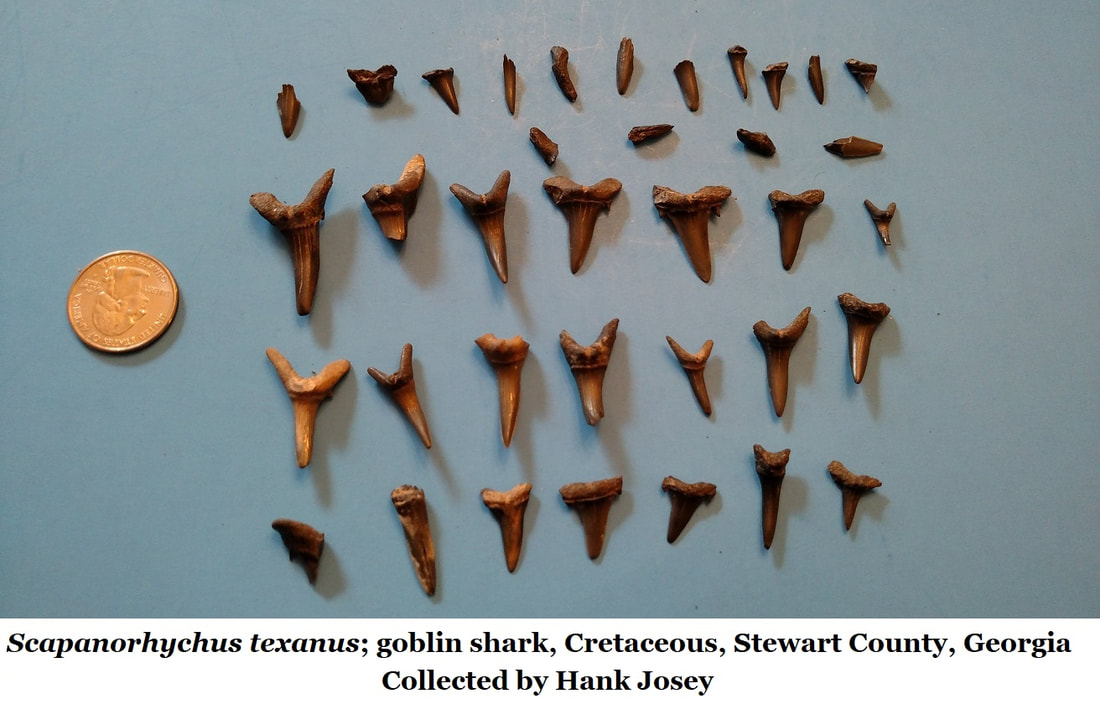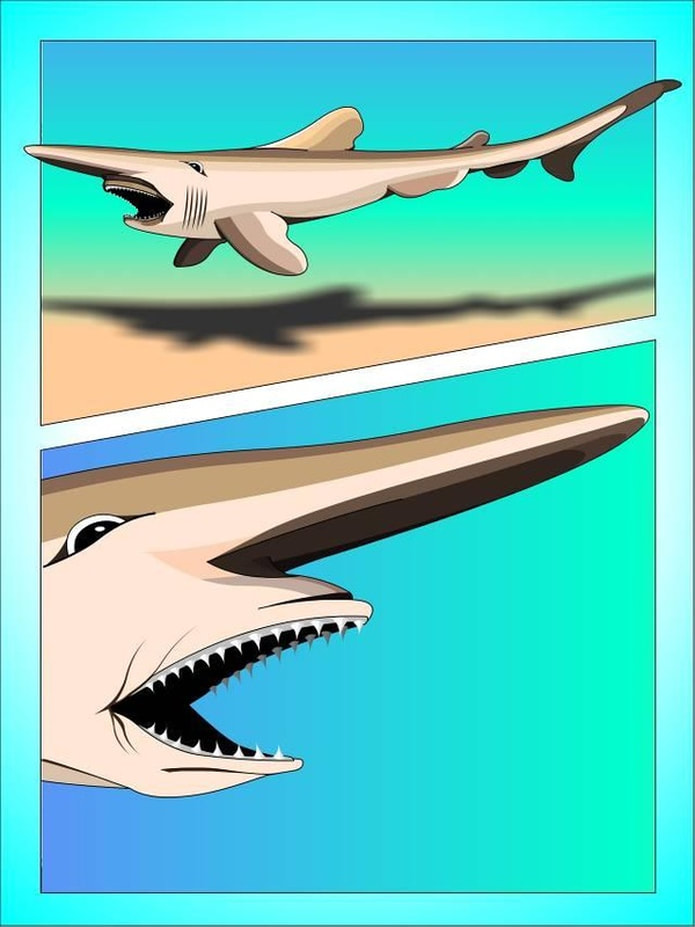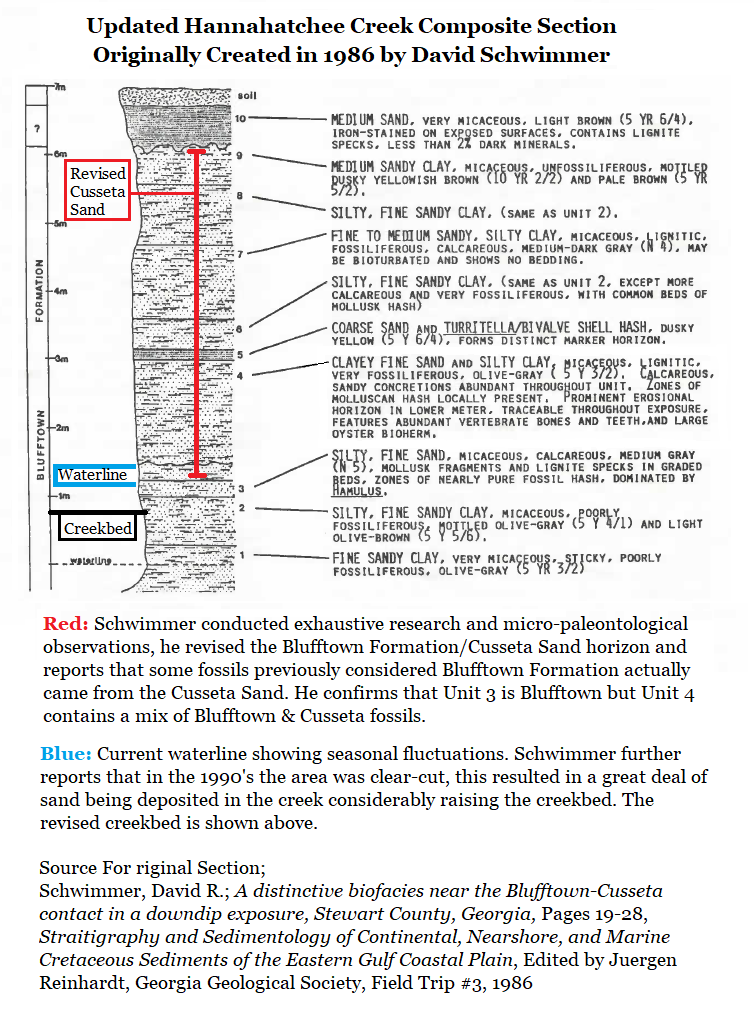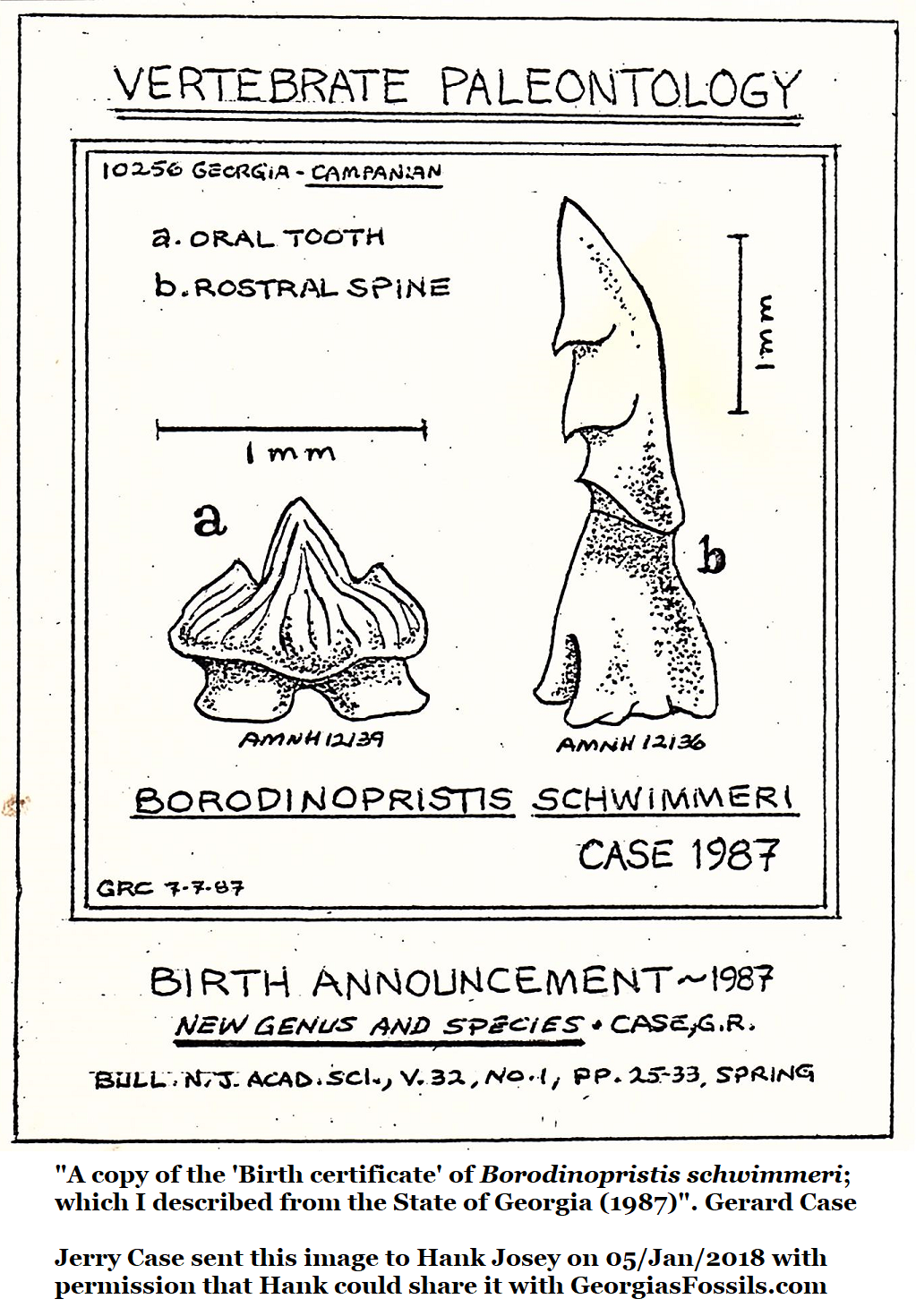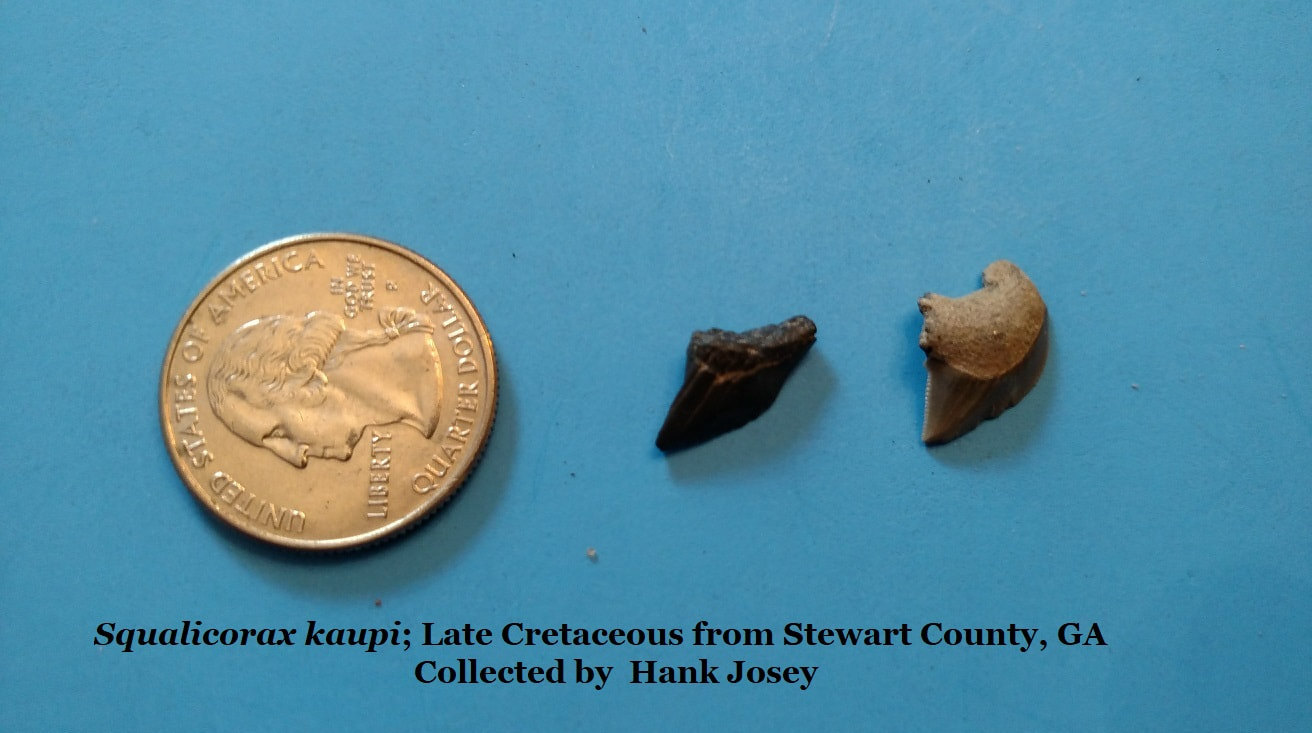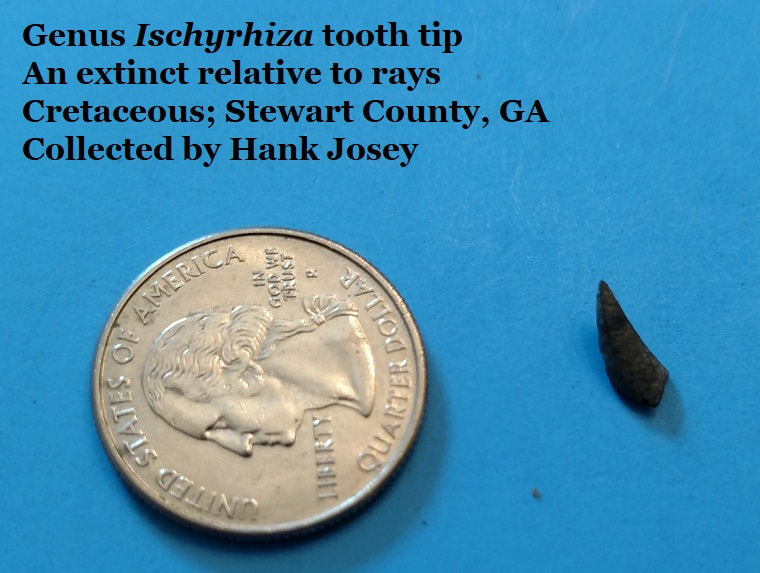7B: So Many Sharks
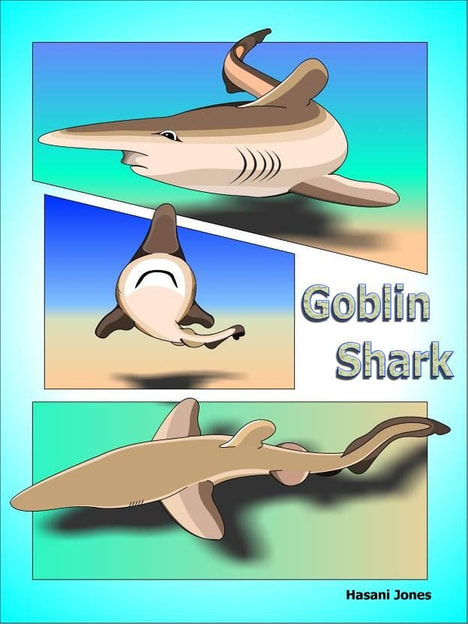
Dr. Schwimmer also participated in a research project which excavated along Hannahatchee Creek’s Blufftown Formation for 77 million year old fossils. When these animals lived this would have been a coastal, near shore environment with the Chattahoochee River emptying into the sea just to the north. Their excavations produced more than a thousand shark’s teeth, turtle shells, bony fish remains, Deinosuchus remains, marine (salt water) reptiles and individual dinosaur fossils.
By far, the most common shark’s tooth belonged to an extinct species of goblin shark, a group of slow swimming sharks with a long snout extending well past its jaws. In modern species the jaws can shoot forward, for most of the length of this snout, when biting. We assume this applies to Cretaceous animals as well.
Artist Hasani Jones has reconstructed the coastal goblin shark Scapanorhynchus texanus for us here as part of the 2011 Georgia Southwestern State University Visual Arts Department Illustration Project.
Modern goblin sharks, a separate but closely related species, are typically about ten feet long and hunt in deep water coastlines. The shallow water species which swam Georgia went extinct with the dinosaurs 65 million years ago but its deep water cousin survived.
***
Note (15/July/2020);
So after detailed observations in micropaleontology, over years, Schwimmer learned that some of the fossils originally attributed to the Blufftown Formation actually came from the overlying Cusseta Sand or the mixed bed between the two.
11/June/2020 Note from Schwimmer: "...many of the fossils I attributed to the Blufftown back in the 80's and early 90's, actually come from the base of the overlying Cusseta Fm. Took me a lot of observation and some microfossil work to figure that the productive bed was actually the basal Cusseta with reworked Blufftown material." (Personal Communication)
(See Section 7I of this website for details.)
***
Several of the other shark finds are noteworthy. One such animal is Borodinopristis schwimmeri, a new species discovered and described directly from Georgia’s Hannahatchee Creek sediments by Gerard C. Case of New Jersey and named for Dr. Schwimmer in honor of his work in this field. Little is yet know about the species except for the teeth of both its snout saw (properly called a rostrum) and the teeth of its mouth. The rostrum teeth are particularly interesting as they are tiny, only about a tenth of an inch long, and barbed.
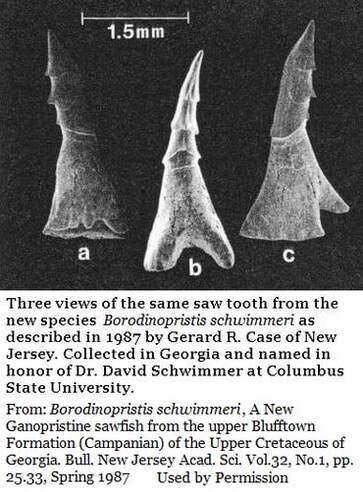
Modern sawfish use their toothed saw to stun or wound prey fish, their small mouths are underneath their head. Sawfish tend to stay close to the bottom; if a prey fish comes near they’ll strike it with their rostrum, or saw, stunning the fish just long enough to swallow it. As far as it is currently known, this new species is restricted to Mississippi, North Carolina & Georgia. (10)
A wealth of sharks inhabited these waters and the evidence of their presence with some idea of their populations can be seen in the fossil record they left behind. Here is a list of shark fossils the team recovered near Hannahatchee Creek from a single area.
Scientific Name Common Name Find
Hybodus (species?) Hump Tooth Tooth & claspers
Lissodus babulskii Thresher family 5 teeth
Squalicorax kaupi Crow Shark 100+ teeth
Pseudocorax affinis Crow Shark 2 teeth
Squatina (species?) Angel Shark 2 teeth
Ginglymostoma globidens Nurse Shark 5 Teeth
Scapanorhynchus texanus Goblin Shark 1,000 + teeth
Synodontaspis holmdelensis Ragged Tooth 2 teeth
Cretolamna appendiculata Mackerel Shark 7 teeth
Cretodus borodini Mackerel Shark 3 teeth
Ischyrhiza mira Sawfish Oral & saw teeth
Ptychotrygon vermiculata Sawfish Oral & saw teeth
Brachyrhizodus romer Cow Nosed Ray Chevrons
Pseudohypolophus Ray (Species?) Chevrons
Rhombodus laevis Guitarfish family 6 teeth
Borodinopristis schwimmeri Sawfish Rostral Tooth
References:
Schwimmer participated with research team fossil excavations into the uppermost beds of the Blufftown Formation along Hannahatchee Creek in 1988. A wealth of Cretaceous material was recovered from a 2 meter thick zone including well over 1000 shark’s teeth, bony fish remains, reptile bones and teeth, abundant turtle fossils and less common fragments from crocodiles, mosasaurs, ornithischian and saurischian dinosaurs.
Borodinopristis schwimmeri, sawfish named for David Schwimmer:
Borodinopristis schwimmeri, A New Ganopristine Sawfish From the Upper Blufftown Formation (Campanian) of the Upper Cretaceous of Georgia. Gerard R. Case, Bulletin, New Jersey Academy of Science, Vol. 32, No.1, pp25-33, Spring 1987.
Late Cretaceous Fish From The Blufftown Formation (Campanian) in Western Georgia. Gerard R. Case and David R. Schwimmer. Journal of Paleontology Vol.62 No. 2, 1988 The Paleontological Society
Schwimmer participated with research team fossil excavations into the uppermost beds of the Blufftown Formation along Hannahatchee Creek in 1988. A wealth of Cretaceous material was recovered from a 2 meter thick zone including well over 1000 shark’s teeth, bony fish remains, reptile bones and teeth, abundant turtle fossils and less common fragments from crocodiles, mosasaurs, ornithischian and saurischian dinosaurs.
Borodinopristis schwimmeri, sawfish named for David Schwimmer:
Borodinopristis schwimmeri, A New Ganopristine Sawfish From the Upper Blufftown Formation (Campanian) of the Upper Cretaceous of Georgia. Gerard R. Case, Bulletin, New Jersey Academy of Science, Vol. 32, No.1, pp25-33, Spring 1987.
Late Cretaceous Fish From The Blufftown Formation (Campanian) in Western Georgia. Gerard R. Case and David R. Schwimmer. Journal of Paleontology Vol.62 No. 2, 1988 The Paleontological Society
